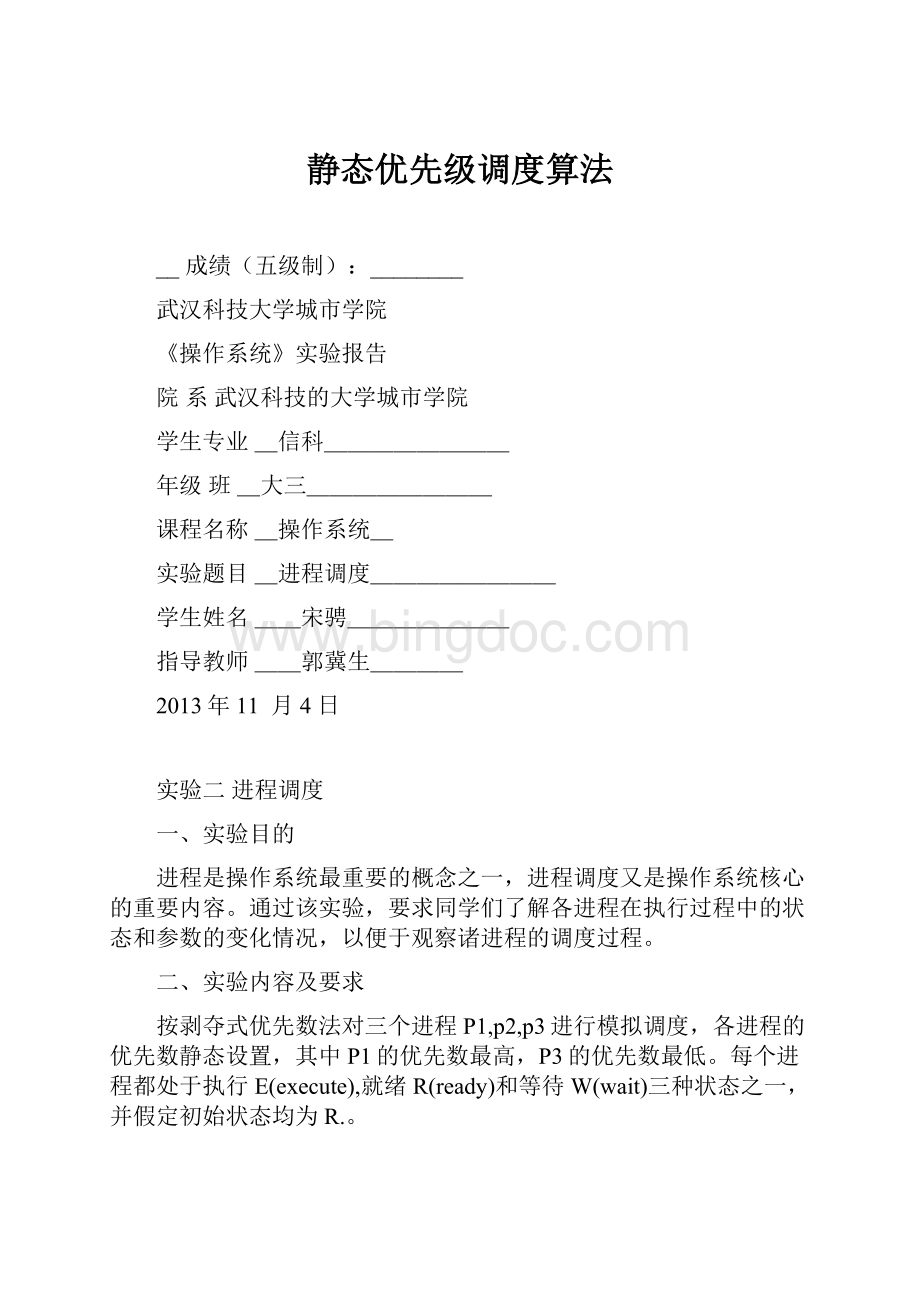静态优先级调度算法.docx
《静态优先级调度算法.docx》由会员分享,可在线阅读,更多相关《静态优先级调度算法.docx(18页珍藏版)》请在冰点文库上搜索。

静态优先级调度算法
__成绩(五级制):
________
武汉科技大学城市学院
《操作系统》实验报告
院系武汉科技的大学城市学院
学生专业_信科________
年级班_大三________
课程名称_操作系统_
实验题目_进程调度________
学生姓名__宋骋_______
指导教师__郭冀生____
2013年11月4日
实验二进程调度
一、实验目的
进程是操作系统最重要的概念之一,进程调度又是操作系统核心的重要内容。
通过该实验,要求同学们了解各进程在执行过程中的状态和参数的变化情况,以便于观察诸进程的调度过程。
二、实验内容及要求
按剥夺式优先数法对三个进程P1,p2,p3进行模拟调度,各进程的优先数静态设置,其中P1的优先数最高,P3的优先数最低。
每个进程都处于执行E(execute),就绪R(ready)和等待W(wait)三种状态之一,并假定初始状态均为R.。
三个进程有如下同步关系:
P1因等待事件1被阻塞后由P2发现并唤醒之,P2因等待事件2被阻塞后由P3发现并唤醒之。
当系统进入运行,在完成必要的初始化工作以后便进入进程调度,首先选择优先数最高的进程使其进入执行(分配CPU)。
当执行进程因等待某个事件被阻塞或唤醒某个等待进程时,转入进程调度。
如果被唤醒的进程的优先数大于现行的执行进程,则剥夺现行进程的执行权,而将CPU分配给被唤醒的进程。
当系统处于死锁或三个进程都执行完毕时系统退出运行。
系统中应用到如下数据结构:
*进程控制块PCB;
*信号量sem;
*其它需要的数据结构。
由自己设计。
三、实验原理及步骤
根据现代操作系统的特征
1.并发性(concurrence);
2.共享性(sharing);
3.虚拟性(virtual);
4.异步性(asynchronism)。
模拟出进程在执行中的状态变化过程;
体会进程申请资源、使用资源、归还资源;
体会死锁。
步骤(参考框图)
4、算法和流程图
可强占优先调度算法实现过程流程图(如下图):
四、程序运行
1选择输入执行程序(如下图)
2可强占优先调度算法图(如下图)
五.设计总结:
通过该课程设计,加深了对系统进程调度机制的理解。
在抢占方式中实践了“抢占”必须遵循的原则:
优先权原则。
认识了几种进程调度算法的优缺点以及应用范围。
加强C++的编程能力,实现类的封
装。
附录:
程序及注释(用红色黑体标注自己设计的函数)
//进程PCB类和模拟cpu的进程类的声明
#include
#include
#include
#include
#include
#include
#include
#include
#include
#defineMAX_PHILOSOPHERS3//待测试的哲学家数
#defineZERO48//数字0的ASCII码
#defineDELAYrand()%25
structPCB
{
charp_name[20];
intp_priority;
intp_needTime;
intp_runTime;
charp_state;
chardeadlock();
structPCB*next;
};
voidHighPriority();
voiddeadlock();
voidInformation();//形参的改变映射给实参说白了就是实参传过去不用return返回就可以把实参改变
charChoice();
structPCB*SortList(PCB*HL);
intmain(intargc,char*argv[])
{
Information();
charchoice=Choice();
switch(choice)
{
case'1':
system("cls");
HighPriority();
break;
case'2':
system("cls");
voiddeadlock();
break;
default:
break;
}
system("pause");
return0;
}
voidInformation()
{
printf("\n\n");
printf("*********************************************\n");
printf("模拟进程调度算法\n");
printf("*********************************************\n\n\n");
printf("静态优先级调度算法");
printf("死锁问题");
printf("按回车键进入演示程序");
getchar();
system("cls");
system("cls");
}
charChoice()
{
printf("\n\n");
printf("*********************************************\n");
printf("进程调度演示\n");
printf("*********************************************\n\n\n");
printf("1.演示最高优先数优先算法。
\n");
printf("2.演示死锁问题。
\n");
printf("3.退出程序。
\n\n\n\n");
printf("选择进程调度方法:
");
printf("selectafunction(1~3):
");
charch=getchar();
returnch;
system("cls");
}
voidHighPriority()
{
structPCB*processes,*pt;
//pt作为临时节点来创建链表
processes=pt=(structPCB*)malloc(sizeof(structPCB));
for(inti=1;i!
=4;++i)
{
structPCB*p=(structPCB*)malloc(sizeof(structPCB));
printf("进程号No.%d:
\n",i);
printf("输入进程名:
");
scanf("%s",p->p_name);
printf("输入进程优先数:
");
scanf("%d",&p->p_priority);
printf("输入进程运行时间:
");
scanf("%d",&p->p_needTime);
p->p_runTime=0;
p->p_state='W';
p->next=NULL;
pt->next=p;
pt=p;
printf("\n\n");
}
getchar();//接受回车
//processes作为头结点来存储链表
processes=processes->next;
intcases=0;
structPCB*psorted=processes;
while
(1)
{
++cases;
pt=processes;
//对链表按照优先数排序
//psorted用来存放排序后的链表
psorted=SortList(psorted);
printf("Theexecutenumber:
%d\n\n",cases);
printf("****当前正在运行的进程是:
%s\n",psorted->p_name);
psorted->p_state='R';
printf("qnamestatesuperndtimeruntime\n");
printf("%s\t%c\t%d\t%d\t%d\t\n\n",psorted->p_name,psorted->p_state,psorted->p_priority,psorted->p_needTime,psorted->p_runTime);
pt->p_state='W';
psorted->p_runTime++;
psorted->p_priority--;
printf("****当前就绪状态的队列为:
\n\n");
//pt指向已经排序的队列
pt=psorted->next;
while(pt!
=NULL)
{
printf("qnamestatesuperndtimeruntime\n");
printf("%s\t%c\t%d\t%d\t%d\t\n\n",pt->p_name,pt->p_state,pt->p_priority,pt->p_needTime,pt->p_runTime);
pt=pt->next;
}
//pt指向已经排序的链表,判断链表是否有已用时间啊等于需要时间的
pt=psorted;
structPCB*ap;
ap=NULL;//ap指向pt的前一个节点
while(pt!
=NULL)
{
if(pt->p_needTime==pt->p_runTime)
{
if(ap==NULL)
{
pt=psorted->next;
psorted=pt;
}
else
ap->next=pt->next;
}
ap=pt;
pt=pt->next;
}
if(psorted->next==NULL)
break;
getchar();
}
}
structPCB*SortList(PCB*HL)
{
structPCB*SL;
SL=(structPCB*)malloc(sizeof(structPCB));
SL=NULL;
structPCB*r=HL;
while(r!
=NULL)
{
structPCB*t=r->next;
structPCB*cp=SL;
structPCB*ap=NULL;
while(cp!
=NULL)
{
if(r->p_priority>cp->p_priority)
break;
else
{
ap=cp;
cp=cp->next;
}
}
if(ap==NULL)
{
r->next=SL;
SL=r;
}
else
{
r->next=cp;
ap->next=r;
}
r=t;
}
returnSL;
}
//
HANDLEh_mutex_chopsticks[MAX_PHILOSOPHERS];//互斥体数组,每根筷子需要一个互斥体
intthread_number[MAX_PHILOSOPHERS]={1,2,3};//定义死锁的个数
//会产生死锁的哲学家线程
intdeadlock_philosopher(LPVOIDdata){
intphilosopher_number=*(int*)(data);//哲学家编号
for(;;)
{
srand((unsigned)time(NULL)*(philosopher_number+1));
Sleep(DELAY);
printf("%s%c%s%c\n","Philosopher",ZERO+philosopher_number,"iswaitingchopstick",(ZERO+philosopher_number));
WaitForSingleObject(h_mutex_chopsticks[philosopher_number],INFINITE);
printf("%s%c%s%c\n","Philosopher",ZERO+philosopher_number,"gotchopstick",(ZERO+philosopher_number));
Sleep(DELAY/4);
printf("%s%c%s%c\n","Philosopher",ZERO+philosopher_number,"iswaitingchopstick",(ZERO+(1+philosopher_number)%MAX_PHILOSOPHERS));
WaitForSingleObject(h_mutex_chopsticks[((1+philosopher_number)%MAX_PHILOSOPHERS)],INFINITE);
printf("%s%c%s%c\n","Philosopher",ZERO+philosopher_number,"gotchopstick",(ZERO+(1+philosopher_number)%MAX_PHILOSOPHERS));
printf("%s%c%s\n","Philosopher",ZERO+philosopher_number,"iseating.");
Sleep(DELAY);
ReleaseMutex(h_mutex_chopsticks[philosopher_number]);
printf("%s%c%s%c\n","Philosopher",ZERO+philosopher_number,"releasedchopstick",ZERO+philosopher_number);
ReleaseMutex(h_mutex_chopsticks[(1+philosopher_number)%MAX_PHILOSOPHERS]);
printf("%s%c%s%c\n","Philosopher",ZERO+philosopher_number,"releasedchopstick",(ZERO+(1+philosopher_number)%MAX_PHILOSOPHERS));
Sleep(DELAY);
}//endfor
return0;
}
//死锁时的初始化程序
voiddeadlock()
{
charchoice;
inti=0;
HANDLEh_thread[MAX_PHILOSOPHERS];
printf("可能出现死锁的哲学家就餐问题\n");
for(i=0;i{
h_mutex_chopsticks[i]=CreateMutex(NULL,FALSE,NULL);
};
for(i=0;i{
h_thread[i]=CreateThread(NULL,0,(LPTHREAD_START_ROUTINE)(deadlock_philosopher),&thread_number[i],0,NULL);
};
WaitForMultipleObjects(MAX_PHILOSOPHERS,h_thread,TRUE,-1);
do
{
choice=(char)getch();
}while(choice!
='2');
system("cls");
deadlock();
printf("\nPressanykeytoreturntomainmenu.");
getch();
system("cls");
}
//通过按序分配资源预防死锁的哲学家线程
intordered_allocation_philosopher(LPVOIDdata)
{
intphilosopher_number=*(int*)(data);
for(;;)
{
srand((unsigned)time(NULL)*(philosopher_number+1));
Sleep(DELAY);
if(philosopher_number==MAX_PHILOSOPHERS-1){
printf("%s%c%s%c\n","Philosopher",ZERO+philosopher_number,"iswaitingchopstick",(ZERO+(1+philosopher_number)%MAX_PHILOSOPHERS));
WaitForSingleObject(h_mutex_chopsticks[(1+philosopher_number)%MAX_PHILOSOPHERS],INFINITE);
Sleep(DELAY/4);
printf("%s%c%s%c\n","Philosopher",ZERO+philosopher_number,"iswaitingchopstick",ZERO+philosopher_number);
WaitForSingleObject(h_mutex_chopsticks[philosopher_number],INFINITE);
}
else{
printf("%s%c%s%c\n","Philosopher",ZERO+philosopher_number,"iswaitingchopstick",ZERO+philosopher_number);
WaitForSingleObject(h_mutex_chopsticks[philosopher_number],INFINITE);
Sleep(DELAY/4);
printf("%s%c%s%c\n","Philosopher",ZERO+philosopher_number,"iswaitingchopstick",ZERO+(1+philosopher_number)%MAX_PHILOSOPHERS);
WaitForSingleObject(h_mutex_chopsticks[(1+philosopher_number)%MAX_PHILOSOPHERS],INFINITE);
}
printf("%s%c%s\n","Philosopher",ZERO+philosopher_number,"iseating.");
Sleep(DELAY);
printf("%s%c%s%c\n","Philosopher",ZERO+philosopher_number,"isreleasingchopstick",ZERO+philosopher_number);
ReleaseMutex(h_mutex_chopsticks[philosopher_number]);
printf("%s%c%s%c\n","Philosopher",ZERO+philosopher_number,"isreleasingchopstick",ZERO+(1+philosopher_number)%MAX_PHILOSOPHERS);
ReleaseMutex(h_mutex_chopsticks[(1+philosopher_number)%MAX_PHILOSOPHERS]);
Sleep(DELAY);
}//endfor
return0;
}
//通过按序分配资源预防死锁的初始化程序
voidordered_allocation()
{
charchoice;
inti=0;
HANDLEh_thread[MAX_PHILOSOPHERS];
printf("可能出现死锁的哲学家就餐问题\n");
for(i=0;ih_mutex_chopsticks[i]=CreateMutex(NULL,FALSE,NULL);
};
for(i=0;ih_thread[i]=CreateThread(NULL,0,(LPTHREAD_START_ROUTINE)(ordered_allocation_philosopher),&thread_number[i],0,NULL);
};
WaitForMultipleObjects(MAX_PHILOSOPHERS,h_thread,TRUE,-1);
do
{
choice=(char)getch();
}while(choice!
='2');
system("cls");
deadlock();
printf("\nPressanykeytoreturntomainmenu.");
getch();
system("cls");
}